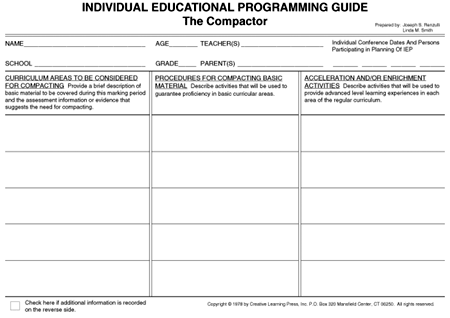Review the form below carefully before you read more about compacting.
The Compactor (Figure 2) is divided into three sections:
- The first column, Curriculum Areas to be Considered for Compacting, should include information on learning objectives and student strengths in those areas. Teachers should list the objectives for a particular unit of study, followed by data on students’ proficiency in those objectives, including test scores, behavioral profiles, and past academic records.
- In the second column, Procedures for Compacting Basic Materials, teachers should detail the pretest vehicles they select, along with test results. The pretest instruments can be formal measures, such as pencil and paper tests, or informal measures, such as performance assessments based on observations of class participation and written assignments.
Specificity is important; recording an overall score of 85% on ten objectives, for example, sheds little light on what portion of the material can be compacted, since students might show limited mastery of some objectives and high levels of mastery on others. - Column three, Accelerations and/or Enrichment Activities, is used to record information about acceleration or enrichment options; in determining these options, teachers must be fully aware of students’ individual interests and learning styles. We should never replace compacted regular curriculum work with harder, more advanced material that is solely determined by the teacher; instead, students’ interests should be taken into account. If for example, a student loves working on science fair projects, that option may be used to replace material that has been compacted from the regular curriculum. We should also be careful to help monitor the challenge level of the material that is being substituted. We want students to understand the nature of effort and challenge and we should ensure that students are not simply replacing the compacted material with basic reading or work that is not advanced.
Next Section: Rationale for Using Curriculum Compacting
Previous Section: An Overview of the Enrichment Triad Model
